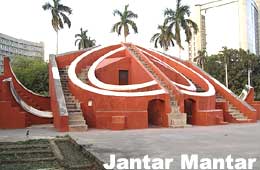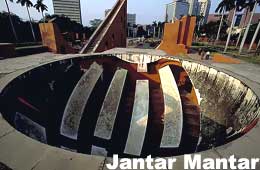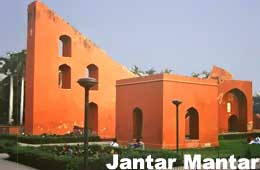| India Profile » Monuments and Temples in India » Jantar Mantar, Delhi | |
Jantar Mantar, Delhi | |
 | |
|
The calculating algorithms for celestial object positions had not been corrected for more than thousand years due to lack of precessions of earth's axis of rotation. This effect was observed as far back as the Vedic times ad is called Ayanamasa. Whenever there was a difference in the calculated and predicted elements due to precessions, ad-hoc corrections called Bija corrections were applied so that the calculations and the observations match each other. These corrections were never organized and classical treatise does not mention these.
The astronomical observations were continuously made over here and were used for drawing up a new set of tables. Thee tables were later compiled as Zij Muhammad Shahi and were dedicated to the reigning monarch. Jai Singh named his observatory as 'Yantra Mantra', in which Yantra means instrument and Mantra means formula. The name got corrupted to Jantar Mantar during British period. The Delhi Observatory consists of four main instruments each of which had other subsidiary functionalities inbuilt. The Samrat Yantra or Prince of Dials is an equinoctial Sun Dial. It is the largest structure in the observatory and was designed by jai Singh himself. It was meant to measure accurate time of the day within half a second and the declination of the sun and other heavenly bodies dominates it. The Misra Yantra was a mixed instrument as the name suggests. It incorporated many important functions. It was meant to determine the shortest and the longest day of the year. The Jayaprakasha Yantra is called the Crest Jewel of instruments and consisted of two complimentary concave hemispheres reflecting the dome of the sky. It was used to show the local time, sun's declination and zodiac signs in an instant.
The Jantar Mantars may have fallen into disuse today. The observatory at Jaipur is n working condition. They will remain an integral part of India's scientific heritage. It presents that India was technologically advance and would have produced rich results if only an opportunity of research and development had been given to it. 'Yantralaya' commonly known as Jantar Mantar was a dream of Swai Jai Singh II, a great astronomer of India. Jantar Mantar was built between 1716. It is located within the city palace. |
|
 |
 Jantar Mantar at Delhi is one of the five masonry observatories built by Raja Sawai Jai Singh of Rajasthan during the early 18th century AD. The remaining four observatories are at Jaipur, Ujjain, Mathura and Varanasi. He was disturbed by the finding that the calculated celestial elements for the Sun, Moon and Planets seemed to disagree with the observations. These celestial elements were used to calculate the planetary movements using classical Indian Astronomical concepts.
Jantar Mantar at Delhi is one of the five masonry observatories built by Raja Sawai Jai Singh of Rajasthan during the early 18th century AD. The remaining four observatories are at Jaipur, Ujjain, Mathura and Varanasi. He was disturbed by the finding that the calculated celestial elements for the Sun, Moon and Planets seemed to disagree with the observations. These celestial elements were used to calculate the planetary movements using classical Indian Astronomical concepts. Jai Singh felt that corrections were needed to be made to the existing methods of calculations with precise observations. Jai Singh constructed a huge observatory of masonry for precise observation. It is made of brick and plaster and consist of extruded, interlocked shapes externally. He started with the brass instruments in his observatory but soon gave them up because of several inherent flaws. They were too small and their axes were unstable displacing the center often. He then decided to follow the style of the renowned Arab astronomer, Prince Ulugh Beg, builder of the famous 15th century AD observatory at Samarkand, Uzbekistan. The massive masonry instruments at the observatory at Samarkand suited Jai Singh's architectural tastes and were far more accurate because of their size.
Jai Singh felt that corrections were needed to be made to the existing methods of calculations with precise observations. Jai Singh constructed a huge observatory of masonry for precise observation. It is made of brick and plaster and consist of extruded, interlocked shapes externally. He started with the brass instruments in his observatory but soon gave them up because of several inherent flaws. They were too small and their axes were unstable displacing the center often. He then decided to follow the style of the renowned Arab astronomer, Prince Ulugh Beg, builder of the famous 15th century AD observatory at Samarkand, Uzbekistan. The massive masonry instruments at the observatory at Samarkand suited Jai Singh's architectural tastes and were far more accurate because of their size.  The Ram Yantra are two complementary buildings in a circular shape, designed for very easy determination of local celestial co-ordinates. The Jayaprakasha and Ram Yantra both are marked out for alternate hours so as to cover the complete passage of an object across the sky.
The Ram Yantra are two complementary buildings in a circular shape, designed for very easy determination of local celestial co-ordinates. The Jayaprakasha and Ram Yantra both are marked out for alternate hours so as to cover the complete passage of an object across the sky.